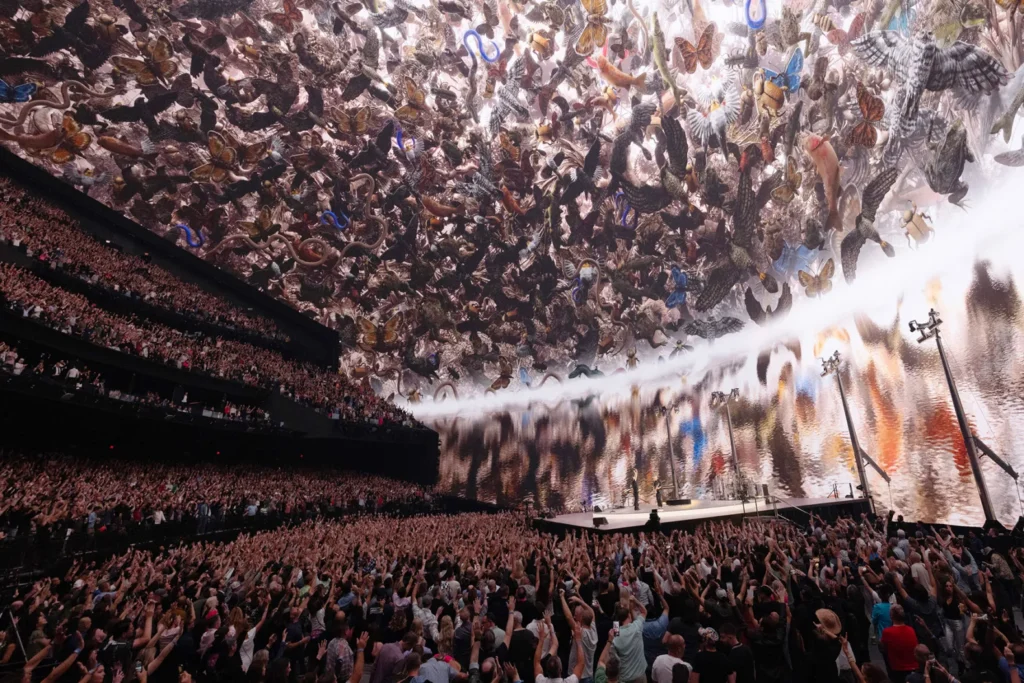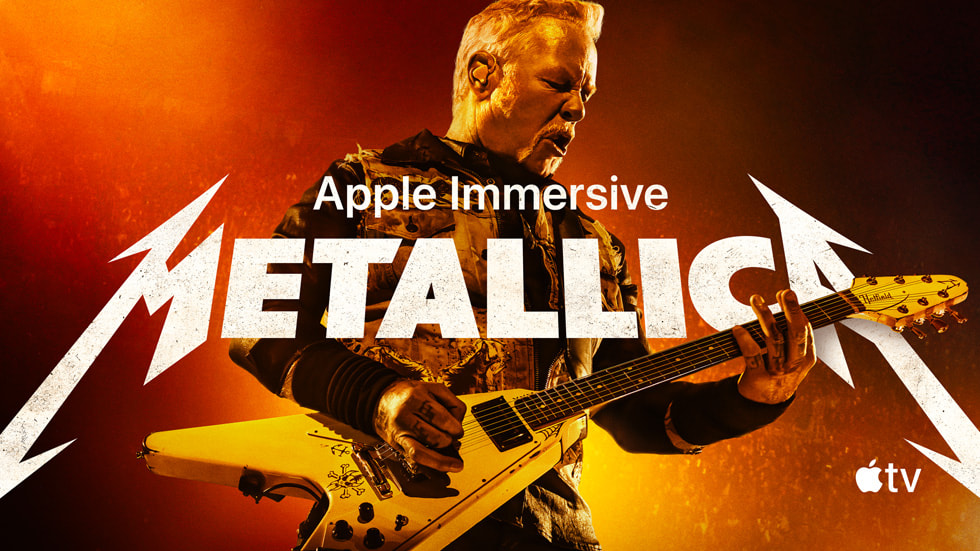Live music has always been about connection—between artist and audience, sound and sensation. But in 2025 and beyond, immersive technology in concerts and the way we experience concerts is evolving beyond anything we imagined even just a few short years ago. From the mind-bending visuals of Anyma’s performances at the Las Vegas Sphere to more recently Metallica’s groundbreaking Apple Vision Pro experience, immersive technology is redefining what it means to attend a live concert.
We covered the early days of AR in music festivals back in 2019 (read here: Augmented Reality at Music Festivals), but what’s happening now is a whole new level of immersion.
🎵 The Sphere in Las Vegas: A Portal to a New Musical Reality

When U2 opened the Las Vegas Sphere, it was a statement—live music was entering an era of sensory overload. But it was Anyma, a visionary artist pushing the boundaries of audiovisual storytelling, who truly unlocked the Sphere’s full potential.
The Sphere isn’t just a venue; it’s an instrument. The 160,000-square-foot LED display, combined with spatialized audio and AI-driven visuals, turns concerts into immersive, cinematic journeys where the boundaries between real and virtual dissolve. With visuals that react in real-time to the music, the concert becomes a shared digital hallucination—a fully synchronized symphony of sound, light, and emotion.
The Sphere’s ability to augment and enhance live performances is just the beginning. Imagine a future where artists perform inside hyper-realistic XR dreamscapes, where the stage is no longer bound by physical constraints.
Check out these performances with similar visualizations:
🔗 Best of Anyma LIVE Afterlife 2024
🎸 Metallica and Apple Vision Pro: A New Era for Virtual Concerts

While the Sphere redefines in-person concerts, Apple is bringing immersive music experiences into people’s homes. On March 11th 2025, Apple unveiled an exclusive Metallica concert for the Vision Pro, offering fans a next-level spatial computing experience unlike anything before.
🔗 Apple’s Metallica Immersive Concert Announcement
🔗 Metallica — Official Trailer | Apple Vision Pro
This isn’t just a concert film—it’s a fully immersive audiovisual event that allows users to experience Metallica’s electrifying performance in a 360-degree, volumetric video format. Fans can step onto the virtual stage, move between vantage points, and even feel as if they are standing in the middle of the crowd, all powered by spatial video and spatial audio.
How This Changes Things: Immersive Technology in Concerts & Live at Home Experiences
1️⃣ From Passive Watching to Active Immersion – Unlike traditional concert films, this experience puts you inside the action, allowing you to move around the stage, switch perspectives, and feel the music in a way that was never possible before.
2️⃣ Revolutionizing Live Music Accessibility – Not everyone can attend a Metallica stadium show, but with the Vision Pro, fans from anywhere in the world can get a front-row experience from their living rooms. This could democratize access to premium live music experiences.
3️⃣ Bridging the Gap Between Physical and Digital – We’re seeing the early stages of a hybrid live music model, where artists will perform for both in-person and digital audiences simultaneously, delivering tailored experiences for both.
Apple’s entry into immersive concerts signals a massive shift—one where technology will allow anyone, anywhere, to experience live music as if they were there.
🌐 Immersive Concerts: The Next Evolution of Live Music
Beyond the Sphere, artists and production teams are using XR (Extended Reality), AI, and real-time rendering to create next-generation live performances. Consider Travis Scott’s Fortnite concert or ABBA’s Voyage holographic residency—both demonstrated that immersive tech can create experiences just as powerful (if not more so) than a traditional stage show.
We’re seeing music, gaming, and virtual reality merge into one—where concerts become full-blown, multi-sensory digital odysseys.
🔥 How This Changes Concerts Forever
1️⃣ From Physical to Digital Realms – With AI-driven visuals, spatial computing, and real-time rendering, concerts can transport audiences into impossible environments. Imagine floating through a cosmic nebula during a deep house set or watching a performer shapeshift into a neon phoenix on stage.
2️⃣ Audience Interaction Will Evolve – Fans won’t just watch; they’ll participate. With AR glasses and haptic tech, live audiences could interact with the performance, manipulating visuals, remixing tracks in real-time, or becoming part of the digital landscape.
3️⃣ Global Accessibility – Live music is about to go global in ways we never expected. The combination of VR concerts, hybrid in-person/virtual shows, and AI-enhanced streaming means fans anywhere in the world can experience concerts with the same intensity as those in the front row.
4️⃣ New Creative Freedom for Artists – Musicians can now think beyond physical stage limitations. Instead of a static venue, the entire world (and beyond) becomes the stage—allowing for hyper-creative, dreamlike, AI-generated visuals that transform performances into fully realized art installations.
The Concert Experience is No Longer Just Physical—It’s Limitless
Not too long ago, the biggest debate in live music was whether phones should be banned at concerts. Now, we’re talking about whether concerts should exist in the real world at all.
As AI, XR, and spatial computing collide, concerts are morphing into something far beyond flashing lights and screaming fans. We’re heading into a future where:
🎭 Holographic openers will be more popular than the real artists they open for
🕶️ Augmented Reality concerts let fans swap out boring visuals for their own hyper-stylized experience
🌍 Massive VR arenas host global concerts where a million people can attend—but the real flex is sitting “front row” in your pajamas
Artists will no longer just play a setlist; they’ll design an entire reality, and the production behind the show will be the real talent. You might be moshing one minute and floating through a psychedelic dreamscape the next. The best part? No overpriced beer or cocktails. No drunk guy spilling it on your shoes. Or perhaps you’d even prefer a that virtual front row seat while you eat snacks on the couch in the comfort of your own home.
But with all this immersion, do we risk losing the raw, unfiltered magic of a live performance? Will concerts become so tailored, so perfect, that they lose their spontaneity? Or is this just the next step in music’s evolution—one where we finally get the show we always imagined in our heads?